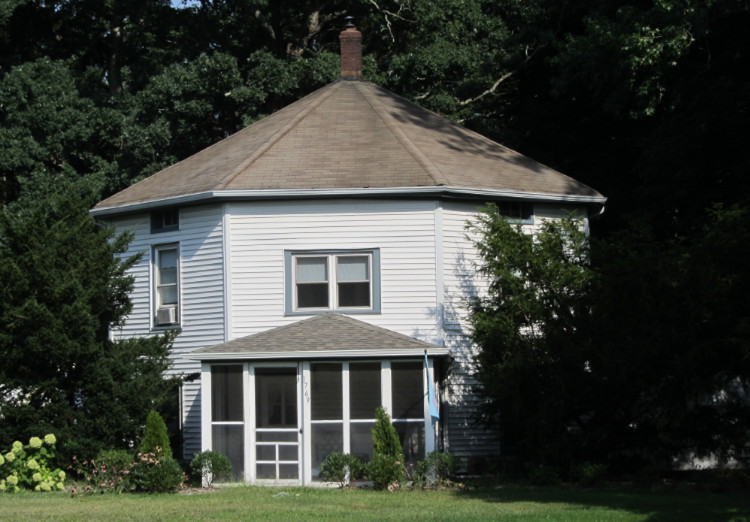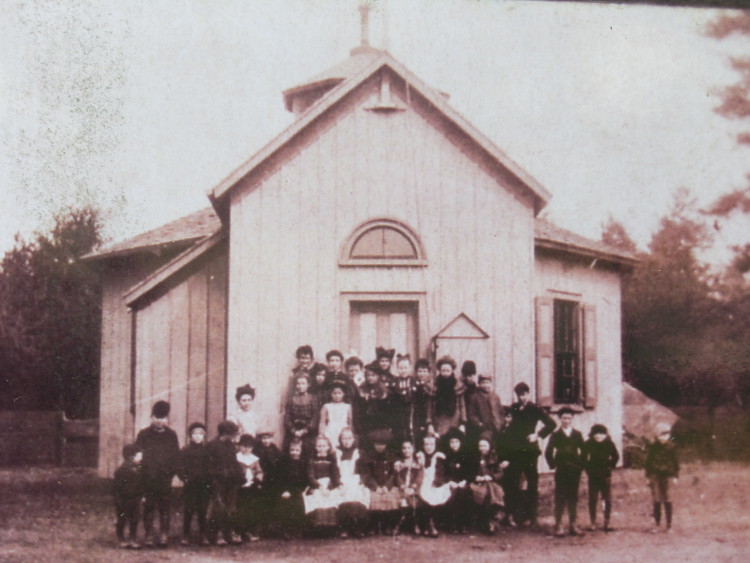This Sunday 150 years ago Long Island’s most famous—and notorious—utopian community formally changed its name from Modern Times to Brentwood. For 13 years this pioneer experiment in communal living had been a haven for non-conformists where “free love” reigned. There was no jail, no police, no judge and no money. The founders’ ideas had attracted international attention in European and American intellectual circles but the residents’ eccentric behavior and out of wedlock living arrangements had drawn heated criticism locally and nationally.
To defuse the controversy while the Civil War was still raging, the leaders of the village met on Sept. 7, 1864 and chose the name of the London suburb where Henry Edger, one of the community’s more noteworthy citizens, had married Milliscent Hobson before emigrating to the U.S. In his book, “Low Living and High Thinking at Modern Times, New York,” Roger Wunderlich, the late founding editor of the “Long Island Historical Journal,” wrote that the residents honored the Edgers not so much for their hometown or their philosophical concerns but for “their ten years of civic service to the village.”
Sadly, few Long Islanders today know much about Modern Times but Brentwood has stuck around through thick and thin.
In 1964, to commemorate this Suffolk community’s centennial, greetings were exchanged between the two Brentwoods, and the English town sent “a handsome illuminated scroll” that is stored at the Brentwood Public Library, according to historian Verne Dyson in his book, “A Century of Brentwood.” As far as is known, there are no plans in the community to mark the 150th anniversary.
The community’s original name was coined by its two founders, Josiah Warren, a 53-year-old philosophical anarchist, and Stephen Pearl Andrews, a 37-year-old polymath fluent in six languages with interests ranging from abolitionism to women’s rights. He became Warren’s editor and partner, but just as important for this fledgling development was his role as a real estate attorney. Warren had been influenced by Robert Owen, the Welsh social reformer and founder of utopian socialism, who had come to the United States on a speaking tour and ultimately founded a community called New Harmony in Indiana that had lasted two years. Andrews was taken with Francois Marie Charles Fourier, the French social theorist who envisioned the creation of a cooperative agricultural community that distributed wealth more equitably than under capitalism.
Late in 1850, Warren and Andrews took the Long Island Rail Road to Thompson’s Station, a whistle stop where Fifth Avenue and Suffolk Avenue are today, to look at property in the Pine Barrens that comprised that part of the town of Islip owned by Dr. Edward Fenn Peck of Smithtown. They liked what they saw and cut a deal.
Months later Warren ran an advertisement in Horace Greeley’s New York Tribune, looking for like-minded newcomers. And so a 90-acre tract eventually became home for at most 150 residents, or “sovereigns” as the founders described them because everyone enjoyed complete individual liberty and unlimited freedom of expression. As Martha Stepsis, the original curator of the Modern Times collection at the Brentwood Public Library, once told the New York Times, their motto was “mind your own business, do your own thing.”
The settlers didn’t put a lot of faith in government but they did believe in the perfectibility of humankind. In particular, the correspondence of Henry Edger with Auguste Comte, the French philosopher who propounded “positivism,” a system of belief based on science and observable phenomena rather than metaphysical speculation or anything supernatural, marked Modern Times as the American center of positivism.
The community started with log cabins and shacks, but soon there were houses, a community center and much more. They performed Shakespeare and debated philosophy and studied science. They practiced the arts and enjoyed creative expression. A reporter for the New York Weekly Leader, visiting in 1854, wrote that women actually asked the men to dance, adding, “This custom is not exclusive; sometimes the men ask the women…By the by, how these Modern Timers do dance!” Fittingly, the first brass band in Suffolk County was formed at Modern Times.
Moncure Daniel Conway, a traveling clergyman, visited in the summer of 1857, when the colony was at its height before the financial panic hit later that year and published his observations: “Every one did what was right in his own eyes. The women wore bloomers or donned the entire male costume. As the sovereignty of the individual was opposed to all artificial, social or legal constraint; marriage was abolished, and families arranged themselves according to the law of attraction. Those lived together who chose to do so, and people parted without giving any trouble to the courts of common pleas. The right of the law either to unite or separate was denied, and free love placed in the same category with all other freedoms.”
Conway saw several thriving businesses like The Time Store, which functioned as the community’s supermarket, a printing plant, a carriage factory, a harness and saddle shop, a cabinet and furniture-making factory and a box factory. Most noticeable was the lack of currency; instead, the residents issued each other promissory notes, payable in terms such as these: “one hours labor in carpenter or furniture work, repairing carriages or musical instruments or eight pounds of corn or (with consent of the holder) ten cents.”
A eulogy for Emily Codman, who died in 1886 and had been married to Charles A. Codman, one of the key proponents of “free love,” tells a lot about why people came to Modern Times. In “our departed sister,” writes H.B. Brown, “they found an apt and enthusiastic disciple imbued with the desire for a truer and more harmonious life than could be found in society as now constituted. She left her New England home to join one of the many attempts then being made to realize such aspirations. This attempt was made at Modern Times, now Brentwood, on the principles taught by Josiah Warren, which it was believed would make it possible for men to deal equitably and justly with each other and so to adjust their relations as to make harmony and peace possible and thus escape the great and growing inharmony in human society and the unequal distribution of wealth from which so many evils spring. The world unfortunately was not then prepared to accept principles so just. Had it been so prepared how different might not society have been today? But we believe it is only a matter of time. The good seed has been sown, the fruitage must someday follow.”

Hard Times Ahead
THESE DAYS the most prominent remains of Modern Times are the original street grid from First to Eight Streets and from First to Eighth Avenues, the remodeled home of Josiah Warren and two 19th century octagonal structures. One is the William Upham Dame House, which has been fully restored and is currently occupied by nuns from the nearby Sisters of St. Joseph Academy. Dame intended it to be a windmill but turned it into his residence on the first floor and an assembly room he called the Archimedean Hall on the second floor.
The other is the original octagonal schoolhouse built in 1857, which served as the only school for 50 years. It is listed in the National Register of Historic Places, but it is in such bad condition that it’s amazing it survived Superstorm Sandy. This “stubborn little building”—as Ellen Edelstein, the president of the Brentwood Historical Society described it admiringly—has already been through a fire and two relocations. Since 1989, the school house has been on the grounds of the Brentwood School District’s Anthony F. Felicio Administration Center when the Town of Islip reportedly paid $15,000 to move it there.
According to a big white billboard still standing along Third Avenue announcing “The Modern Times Original Schoolhouse Restoration Project,” there were once very ambitious plans for this octagon. But the wording in red letters reveals a sadder conclusion: “Construction to begin summer of 2005.” Apparently promised public funding fell through, the historical society fell apart, and the district landed in a lawsuit with the architect listed on the billboard. No one in the school administration would comment about it on the record and the architect did not return repeated calls. Consequently, the “one room school octagon” is in even worse condition than it was nine years ago.
“It is in terrible, terrible shape,” Edelstein told the Press. A retired math teacher who taught in the district, Edelstein became president of the historical society two years ago after the group had languished for many years. “I’m not a history person; I’m a Brentwood person,” she explained proudly, mentioning that she’s been living in the community since she was a teenager.
The process is daunting. “It’s got to be taken apart piece by piece,” Edelstein said. “Whatever can be salvaged from the original structure can be incorporated in the new structure and then replicated materials will produce the rest of it.”
In its prime, the school house was quite innovative and spacious, she said. “The people of Modern Times were extremely efficient, resourceful, and environmentally conscious,” she explained. “This building was designed to make maximum use of natural light.”
She has vowed to get the octagon restored and has plans in the works that were too premature to reveal at this point. The school district, constantly hard-pressed for funds, would welcome the support. Estimates for the project range from hundreds of thousands of dollars to more than a million.
“We hope to see the octagonal school house fully restored someday so future generations of Brentwood can experience it as it was intended and honor the legacy of this utopian community that left it for us,” said Felix Adeyeye, a spokesman for the Brentwood school district.
But when that octagonal school room will ever be ready to admit the curiosity seeker, let alone Brentwood students wishing to study their community’s unique history, is anybody’s guess.
Until it happens, Modern Times is a thing of the past.






























